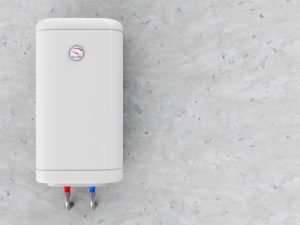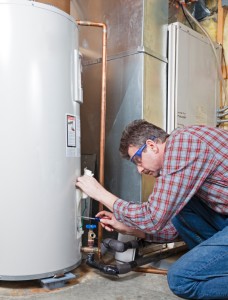How do you know when your water tank has stopped performing as well as it should be? It’s not a simple appliance to open up and look at, but there are some easy to detect symptoms that give away a more serious underlying problem.
 These easy to see symptoms include:
These easy to see symptoms include:
Here’s what you need to know about each.
The likely cause is corrosion on the inside of your tank. Corrosion can deteriorate the dip tube, overload the gas valve or coat your electric elements. A shortage of hot water is a clear sign your tank is over the hill.
How old is your tank? If it’s 10 years old (or so) and you can’t find the leak, it’s probably:
The cost of a repair is as expensive as replacing the tank completely, so 100% of clients choose to upgrade to a new unit at this point rather than repair the old relic.
The most likely problem comes from your thermocouple or gas valve.
 The tip of a properly installed thermocouple rests around half an inch inside the pilot flame. It generates just enough energy to power a tiny electromagnet keeping the pilot valve open.
The tip of a properly installed thermocouple rests around half an inch inside the pilot flame. It generates just enough energy to power a tiny electromagnet keeping the pilot valve open.
If the thermocouple is damaged or not sitting properly, the valve won’t have enough power to stay open.
You can check to see if the thermocouple is properly positioned. The thermocouple can be found just below the thermostat on your water tank. It’s slightly different on every model, so bring a flashlight and look around.
If it appears in the right position, you may have a faulty thermocouple. If you replace the thermocouple and the pilot still goes out, your electromagnet may no longer work and you may need a new gas valve or high limit switch.
If your tank is outside the warranty, replacing the gas valve isn’t worth the money, once you account for parts and labour. It’s better to find a new tank-type or tankless water heater.
You should drain the hot water tank at least once each year to remove sediment.
If you haven’t done this, a single layer of sediment will quickly grow to many layers of sediment. This is bad because the sediment acts as a buffer between the heating flame and the water in your tank. The flame burns longer to get the water up to your desired temperature, and the extra heat from the flame on the tank weakens the tank faster than under normal conditions.
Build-up of sediments results in lost capacity – 50 gallons may turn into 40 gallons over time.
If your water tank is so full of sediment it doesn’t drain at all when you open the valve, there is no use trying to fix it. Time for a new tank.
 Modern tanks contain a check valve on the cold inlet side of the water heater to save energy. It prevents hot water from running up the cold inlet waterline when there is a drop in pressure on the cold side.
Modern tanks contain a check valve on the cold inlet side of the water heater to save energy. It prevents hot water from running up the cold inlet waterline when there is a drop in pressure on the cold side.
But the check valve creates new challenges.
When water is heated, it expands and has to go somewhere. With the introduction of check valves, expansion is limited. Hot water and cold water tanks can’t really support each other, and you end up with poor pressure on the hot side of the tank.
A simple fix is installing a small expansion tank on the hot side.
If you get short bursts of pressure when you first turn on a hot faucet, or no pressure at all, your check valve is probably stuck. The check valve is a small plastic ball in a short chamber that floats when not under pressure and is pushed out of the way when under pressure.
An old tank can see scale buildup on the check valve, forcing it to stay in one position rather than moving. In this case, the scale buildup is a sign of a tank that is too far gone for repairs.
When you experience these issues, consider upgrading to a tankless water heater. You’ll go without any of these frustrating, potentially costly issues, and you’ll have all the hot water you need whenever you need it.
Get in touch with a member of our team today to price out a few options.
